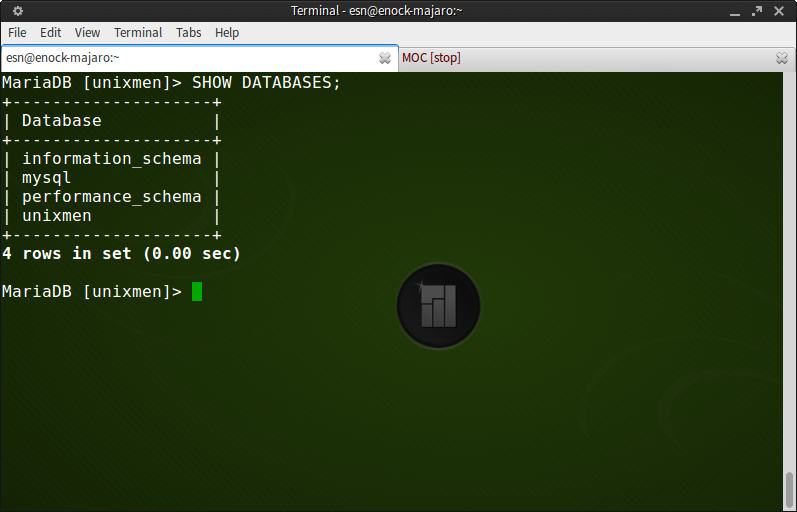MariaDB is a community-developed fork of the MySQL relational database management system, the impetus being the community maintenance of its free status under the GNU GPL. Being a fork of a leading open source software system, it is notable for being led by its original developers and triggered by concerns over direction by an acquiring commercial company Oracle.
Since March 2013 MariaDB has replaced MySQL in Arch repositories.
In this tutorial am installing MariaDB in Manjaro 0.8.8
Update Packages:
$ sudo pacman -Syu
Installing MariaDB:
$ sudo pacman -S mysql
Choose provider of your choice if prompted:
[esn@enock-majaro ~]$ sudo pacman -S mysql [sudo] password for esn: :: There are 2 providers available for mysql: :: Repository extra 1) mariadb :: Repository community 2) percona-server Enter a number (default=1): # PRESS ENTER resolving dependencies... looking for inter-conflicts... Packages (4): libaio-0.3.109-7 libmariadbclient-5.5.34-3 mariadb-clients-5.5.34-3 mariadb-5.5.34-3 Total Download Size: 17.71 MiB Total Installed Size: 159.54 MiB :: Proceed with installation? [Y/n] Y :: Retrieving packages ...
Start MariaDB:
$ sudo systemctl start mysqld
Securing MariaDB Installation:
$ sudo mysql_secure_installation
NOTE: RUNNING ALL PARTS OF THIS SCRIPT IS RECOMMENDED FOR ALL MariaDB SERVERS IN PRODUCTION USE! PLEASE READ EACH STEP CAREFULLY! In order to log into MariaDB to secure it, we'll need the current password for the root user. If you've just installed MariaDB, and you haven't set the root password yet, the password will be blank, so you should just press enter here. Enter current password for root (enter for none): OK, successfully used password, moving on... Setting the root password ensures that nobody can log into the MariaDB root user without the proper authorisation. Set root password? [Y/n] Y New password: Re-enter new password: Password updated successfully! Reloading privilege tables.. ... Success! By default, a MariaDB installation has an anonymous user, allowing anyone to log into MariaDB without having to have a user account created for them. This is intended only for testing, and to make the installation go a bit smoother. You should remove them before moving into a production environment. Remove anonymous users? [Y/n] Y ... Success! Normally, root should only be allowed to connect from 'localhost'. This ensures that someone cannot guess at the root password from the network. Disallow root login remotely? [Y/n] Y ... Success! By default, MariaDB comes with a database named 'test' that anyone can access. This is also intended only for testing, and should be removed before moving into a production environment. Remove test database and access to it? [Y/n] Y - Dropping test database... ... Success! - Removing privileges on test database... ... Success! Reloading the privilege tables will ensure that all changes made so far will take effect immediately. Reload privilege tables now? [Y/n] Y ... Success! Cleaning up... All done! If you've completed all of the above steps, your MariaDB installation should now be secure. Thanks for using MariaDB!
Verify your root credentials by logging on to MariaDB:
$ mysql -u root -p
[esn@enock-majaro ~]$ mysql -u root -p
Enter password:
Welcome to the MariaDB monitor. Commands end with ; or \g.
Your MariaDB connection id is 11
Server version: 5.5.34-MariaDB-log MariaDB Server
Copyright (c) 2000, 2013, Oracle, Monty Program Ab and others.
Type 'help;' or '\h' for help. Type '\c' to clear the current input statement.
MariaDB [unixmen]> SHOW DATABASES;
+--------------------+
| Database |
+--------------------+
| information_schema |
| mysql |
| performance_schema |
| unixmen |
+--------------------+
4 rows in set (0.00 sec)
MariaDB [unixmen]>






